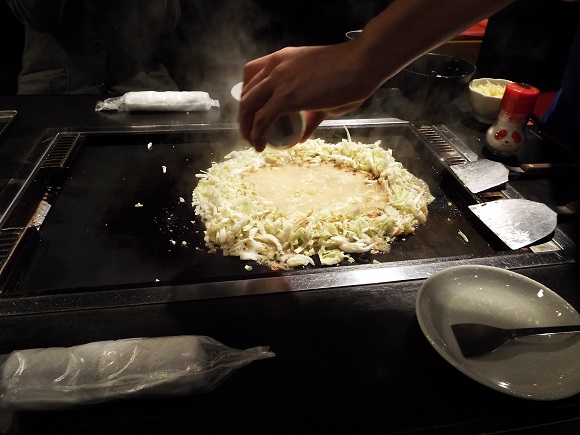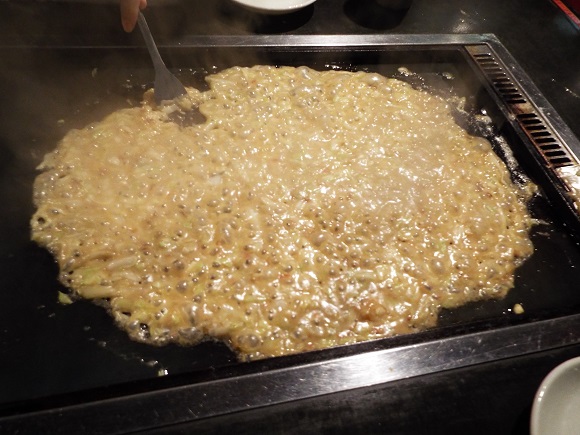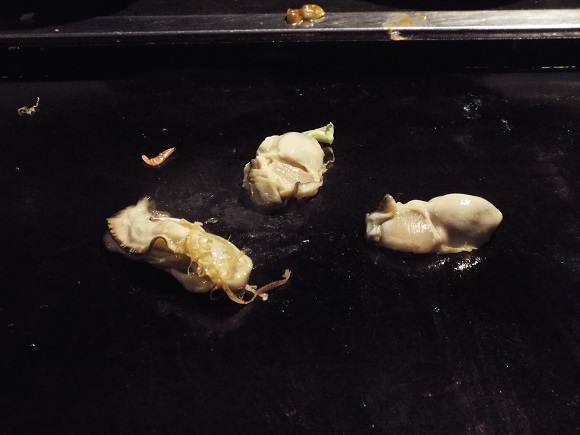
Japan is, of course, known for its unique cuisine. From sushi to takoyaki, there’s something for everyone! One domestic favorite is the cabbage-pancake okonomiyaki, which can include anything from squid to pork to cheese. The dish is beloved by both children and adults throughout the country and can be found in restaurants, festivals, and even hamburgers! However, if you live in Tokyo, you’d probably want to some monjayaki instead, a similar dish that is closer in consistency to scrambled eggs–but still incredibly delicious!
Last weekend, we headed out to Tsukishima, one of the most famous mojayaki destinations in Japan, to try the dish. Check out our report of the excellent monjayaki shop, Bambi, below!
Monjayaki uses a batter very similar to okonomiyaki, as well as a liberal helping of cabbage. Mixed in with the cabbage can be pretty much anything you want–from cheese to oysters to tomatoes. One big difference between monjayaki and okonomiyaki is how they’re cooked: Okonomiyaki is much thicker with both sides crispy like a pancake. Monjayaki, on the other hand, tends to be eaten while it’s still soft and is also usually spread very thin, allowing children to practice writing hiragana on the grill. With monjayaki, it’s completely fine to play with your food!
Being a Kanto dish, monjayaki isn’t always well-loved by folks from Osaka, but for the rest of us, it can be just as good (or maybe even better) than okonomiyaki.
Recently, we headed out to Tsukishima, an man-made island in Tokyo Bay and home to the famous monjayaki street, Nishinakadori, to try the real deal! But with dozens of monjayaki shops to choose from, we were initially at a loss–how could we decide?? But then an answer appeared: Bambi!
▼ Best restaurant mascot ever?
We had perfect timing and arrived around 11:50am while the shop was still mostly empty. By the time we left around an hour later, it was packed! But once we got some of that monjayaki in our mouths, we totally understood why. So delicious!
A waiter showed us to our table, which was basically a flat-top grill with a smoke exhaust fan overhead.
Once we got settled, we took a look at their menu. There were so many different dishes it almost made you dizzy!
After a few minutes of intense debate, we settled on three versions of monjayaki: Cheese, oyster, and one of Bambi’s specialty versions, Italian. The prices, in case you’re wondering, were about what you would expect for Tokyo: 910 yen (about US$9.20) for the cheese, 980 yen (about $9.90) for the oyster, and 1,320 yen (about $13.30) for the Italian. After we’d ordered, the waiter turned on the grill, slapped down some oil, and disappeared for a few minutes while it warmed up.
Reappearing later with two bowls–one of cheese and one with the batter and cabbage, the waiter offered to cook the first batch for us. We couldn’t pass up the chance to have a pro cook for us!
The process is relatively simple, but there are a few things you want to be careful of if you’re cooking for yourself. First, throw the seasoning on the grill.
Once your seasonings and whatever else is on top of the cabbage is warmed up, you can toss the cabbage on and mix it all together. At this point, you’re basically stir frying it all together.
Once you’re happy with your cabbage, you want to make a ring like in the picture below. No, this isn’t for summoning ancient spirits–this is where the batter goes!
▼ Try to keep the batter in the ring. It’s probably not necessary, but it looks cool!
After pouring the batter into the ring of cabbage and seasonings, you can add spices and sauces if you want. If you’re sharing, we recommend just adding a little bit to the main batch and then applying more to match your individual taste once you have it on your plate.
Finally, throw in whatever’s left, like the cheese, and scramble it all together!
▼ Sizzling goodness!
At this point, it will basically have the consistency of eggs mid-scramble, so just keep mixing and chopping.
Finally, spread it all out like in the picture below and just let it cook! Now you have to answer a very serious question: How crispy do you want your monjayaki? Some people prefer to eat it while it’s still slightly runny and others want it nice and crispy. The choice is yours! If you do prefer to wait for the batter to solidify a bit more, now’s your chance to practice writing.
▼ We ran out of room for the “24.”
Once you’re satisfied with the texture, you can pull off chunks as you please! This is the cheese monjayaki. Between the cheese, the tangy sauce, the rich batter, and the cabbage, it was literally the best thing I put in my mouth all week!
Here’s the sauce!
Once we’d finished the cheese monjayaki, it was time to try cooking for ourselves! Next up was the oysters, so first we got them sizzling and then we just copied the waiter.
Finally, out came the Italian monjayaki. This was a bit more elaborate, though cooking it was basically the same. While other monjayaki dishes only had one extra ingredient, this had three: Beef, cheese, and tomatoes. After getting the tomatoes and beef hot, it’s the same as cooking the cheese version. However, you’ll probably want to chop the tomatoes into smaller pieces to make it easier to pull your helpings off the grill with your tiny, adorable spatula.
After three dishes of monjayaki, we were too full to even ask for dessert. Which was too bad, because we spotted a specialty frozen treats store on the way home. Well, I guess we’ll just have to go back another day and eat some more. Oh, darn!
While you can find monjayaki in other parts of Japan, Tsukishima may have the best and widest selection. So if you’re in Tokyo looking for some great local food, jump on the Oedo or Yurakucho subway line and head to the island. Your mouth will thank you!
Bye, Bambi! We’ll see you again soon!
All images by RocketNews24



























 Monjayaki vending machine appears in Tokyo
Monjayaki vending machine appears in Tokyo Monjayaki, the popular Tokyo dish you’ve probably never heard of 【RocketKitchen】
Monjayaki, the popular Tokyo dish you’ve probably never heard of 【RocketKitchen】 We made monjayaki with a Pon de Monja doughnut!
We made monjayaki with a Pon de Monja doughnut! Mr. Sato tries monjayaki for the first time, goes all in with new “innovative” European flavors
Mr. Sato tries monjayaki for the first time, goes all in with new “innovative” European flavors We cook a monjayaki Japanese pancake on the hood of a car during Japan’s hottest summer ever【Vid】
We cook a monjayaki Japanese pancake on the hood of a car during Japan’s hottest summer ever【Vid】 Majority of Japanese mayors say foreign residents are essential but most see good and bad effects
Majority of Japanese mayors say foreign residents are essential but most see good and bad effects Rakuten randomly offers 58 New Year’s osechi feasts in Japan, but did we get a star or a dud?
Rakuten randomly offers 58 New Year’s osechi feasts in Japan, but did we get a star or a dud? Tokyo fish market breaks New Year auction record as single fish sells for over 5 million yen【Vid】
Tokyo fish market breaks New Year auction record as single fish sells for over 5 million yen【Vid】 Beautiful sightseeing boat is a floating tea ceremony venue in east Japan’s best hot spring town
Beautiful sightseeing boat is a floating tea ceremony venue in east Japan’s best hot spring town Japanese avoiding domestic travel as foreign tourists increase, possibly creating vicious cycle
Japanese avoiding domestic travel as foreign tourists increase, possibly creating vicious cycle Shinkansen: “Seats can be quickly used as shields in the event of an attack”
Shinkansen: “Seats can be quickly used as shields in the event of an attack” The results are in! One Piece World Top 100 characters chosen in global poll
The results are in! One Piece World Top 100 characters chosen in global poll Godzilla-shaped ice cream on sale in Tokyo near the sight his most adorable rampage
Godzilla-shaped ice cream on sale in Tokyo near the sight his most adorable rampage Four Shinto shrines to pray for love at in Japan to start the New Year
Four Shinto shrines to pray for love at in Japan to start the New Year Snowman Totoro, other self-righting dolls never stay down, will always keep your spirits up【Pics】
Snowman Totoro, other self-righting dolls never stay down, will always keep your spirits up【Pics】 Starbucks Japan ready to get Year of the Horse started with adorable drinkware and plushies【Pics】
Starbucks Japan ready to get Year of the Horse started with adorable drinkware and plushies【Pics】 Hayao Miyazaki says Happy New Year to Studio Ghibli fans with new art for Year of the Horse
Hayao Miyazaki says Happy New Year to Studio Ghibli fans with new art for Year of the Horse Japanese beef bowl chain Sukiya’s 2026 Smile Box lucky bag basically pays for itself
Japanese beef bowl chain Sukiya’s 2026 Smile Box lucky bag basically pays for itself We found possibly the quietest Japanese-style hotel in Tokyo’s bustling Shinjuku district
We found possibly the quietest Japanese-style hotel in Tokyo’s bustling Shinjuku district Cup Noodle tries an authentic Jiro-style ramen, but something’s not quite right
Cup Noodle tries an authentic Jiro-style ramen, but something’s not quite right The best Starbucks Japan Frappuccinos we want to drink again in 2026
The best Starbucks Japan Frappuccinos we want to drink again in 2026 We revisited Sweets Paradise after a decade to see if Japan’s dessert buffet still delivers
We revisited Sweets Paradise after a decade to see if Japan’s dessert buffet still delivers That time Seiji called JASRAC to ask why he didn’t get paid royalties for his song being on TV
That time Seiji called JASRAC to ask why he didn’t get paid royalties for his song being on TV Japan’s oldest largetooth sawfish in captivity back on display in Mie Prefecture
Japan’s oldest largetooth sawfish in captivity back on display in Mie Prefecture Pizza Hut Japan’s hot lucky bags are perfect for a New Year’s pizza party
Pizza Hut Japan’s hot lucky bags are perfect for a New Year’s pizza party 7-Eleven Japan starts new temporary luggage storage service in over 300 branches
7-Eleven Japan starts new temporary luggage storage service in over 300 branches Disillusionment at Tsukiji’s tourist-target prices led us to a great ramen restaurant in Tokyo
Disillusionment at Tsukiji’s tourist-target prices led us to a great ramen restaurant in Tokyo Starbucks teams up with 166-year-old Kyoto doll maker for Year of the Horse decorations【Photos】
Starbucks teams up with 166-year-old Kyoto doll maker for Year of the Horse decorations【Photos】 Tokyo considering law requiring more trash cans following litter increase in heavily touristed area
Tokyo considering law requiring more trash cans following litter increase in heavily touristed area Tokyo’s Tsukiji sushi neighborhood asks tour groups to stay away for the rest of the month
Tokyo’s Tsukiji sushi neighborhood asks tour groups to stay away for the rest of the month Tokyo event lets you travel back in time, for free, to celebrate 100 years since Showa era start
Tokyo event lets you travel back in time, for free, to celebrate 100 years since Showa era start Japan may add Japanese language proficiency, lifestyle classes to permanent foreign resident requirements
Japan may add Japanese language proficiency, lifestyle classes to permanent foreign resident requirements Sanrio theme park in Japan announces plans to expand into a Sanrio resort
Sanrio theme park in Japan announces plans to expand into a Sanrio resort Stamina-destroying “Paralysis Noodles” are Tokyo’s newest over-the-top ramen innovation
Stamina-destroying “Paralysis Noodles” are Tokyo’s newest over-the-top ramen innovation Survey asks foreign tourists what bothered them in Japan, more than half gave same answer
Survey asks foreign tourists what bothered them in Japan, more than half gave same answer Japan’s human washing machines will go on sale to general public, demos to be held in Tokyo
Japan’s human washing machines will go on sale to general public, demos to be held in Tokyo Japan’s deadliest food claims more victims, but why do people keep eating it for New Year’s?
Japan’s deadliest food claims more victims, but why do people keep eating it for New Year’s? We deeply regret going into this tunnel on our walk in the mountains of Japan
We deeply regret going into this tunnel on our walk in the mountains of Japan Studio Ghibli releases Kodama forest spirits from Princess Mononoke to light up your home
Studio Ghibli releases Kodama forest spirits from Princess Mononoke to light up your home Major Japanese hotel chain says reservations via overseas booking sites may not be valid
Major Japanese hotel chain says reservations via overseas booking sites may not be valid Put sesame oil in your coffee? Japanese maker says it’s the best way to start your day【Taste test】
Put sesame oil in your coffee? Japanese maker says it’s the best way to start your day【Taste test】 No more using real katana for tourism activities, Japan’s National Police Agency says
No more using real katana for tourism activities, Japan’s National Police Agency says Starbucks Japan reveals new sakura drinkware collection, inspired by evening cherry blossoms
Starbucks Japan reveals new sakura drinkware collection, inspired by evening cherry blossoms Updated cherry blossom forecast shows extra-long sakura season for Japan this year
Updated cherry blossom forecast shows extra-long sakura season for Japan this year How to make okonomiyaki at home【SoraKitchen】
How to make okonomiyaki at home【SoraKitchen】 Could one of Osaka’s Most Famous Dishes Actually Originate from Tokyo?
Could one of Osaka’s Most Famous Dishes Actually Originate from Tokyo? Monjayaki in a cup is the new instant ramen everyone’s talking about right now【Taste Test】
Monjayaki in a cup is the new instant ramen everyone’s talking about right now【Taste Test】 Best all-you-can-eat okonomiyaki in Japan? Restaurant chain serves up a feast for under $14
Best all-you-can-eat okonomiyaki in Japan? Restaurant chain serves up a feast for under $14 Japan’s longest-running okonomiyaki joint and the birthplace of Hiroshima style — We visit both
Japan’s longest-running okonomiyaki joint and the birthplace of Hiroshima style — We visit both We love Gudetama so much, we turn him into adorable okonomiyaki pancakes and eat him!
We love Gudetama so much, we turn him into adorable okonomiyaki pancakes and eat him! Move over ramen and udon, “cup okonomiyaki” has come to play*
Move over ramen and udon, “cup okonomiyaki” has come to play* “Flat Takoyaki” at Nanpuu reimagines Japanese street food
“Flat Takoyaki” at Nanpuu reimagines Japanese street food Kyoto restaurant chain specialises in…tomato okonomiyaki?
Kyoto restaurant chain specialises in…tomato okonomiyaki? Rice cooker recipe: How to make a giant cheesy okonomiyaki pancake in a rice cooker
Rice cooker recipe: How to make a giant cheesy okonomiyaki pancake in a rice cooker Okonomiyaki sauce producer on damage control following heightened Iran-US tensions
Okonomiyaki sauce producer on damage control following heightened Iran-US tensions Cup Noodle releases extremely modified versions of their original flavors【Taste test】
Cup Noodle releases extremely modified versions of their original flavors【Taste test】 This Japanese bar snack also makes for a great camping meal【Recipe】
This Japanese bar snack also makes for a great camping meal【Recipe】 Microwavable okonomiyaki that you can eat with one hand? Yes, please!
Microwavable okonomiyaki that you can eat with one hand? Yes, please! We make Russian food based only on the sound of its name, somehow everyone who ate it survived
We make Russian food based only on the sound of its name, somehow everyone who ate it survived Lotteria craziness continues with the new okonomiyaki burger
Lotteria craziness continues with the new okonomiyaki burger
Leave a Reply